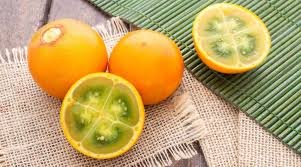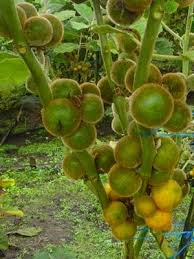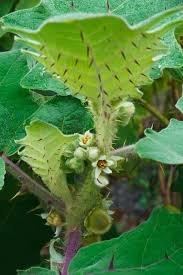 Image 1 of 3
Image 1 of 3

 Image 2 of 3
Image 2 of 3

 Image 3 of 3
Image 3 of 3




Naranjilla Plant (Solanum Quitoense)
This is a project years in the making. I have tried multiple times to grow this plant to fruit and have finally done so! I let it go with no water or nothing. These seedlings are what survived. Strong offspring cultivated at CRISP from thousands of seeds.
And now you get to take a front row seat with Rick Moranis at The Little Shop of Horrors or share a nice drink with that friend who grew up imbibing the amazing juice that can be made from the fruit. Naranjilla is a tropical perennial plant from northwestern South America and is known as Lulo in Colombia.
The plant has large elongated heart- or oval-shaped leaves up to 45 cm in length. The leaves and stems of the plant are covered in short purple hairs and spikes. Naranjilla are delicate plants and must be protected from strong winds and direct sunlight. I learned this after crossing the Crescent City Connection with a load of plants bound for Marrero. So take caution. They grow best in dappled sunlight and even partial shade making them an excellent understory plant for your edinble forest. They can also be kept in a container on a porch to dazzle your friends and neighbors.
The fruit has a citrus flavour, sometimes described as a combination of rhubarb and lime. The juice of the naranjilla is green and is often used as a juice or for a drink called lulada.This is a one of a kind plant cultivated with care at CRISP.
Classification: Within the genus Solanum, S. quitoense is a part of the subgenus Leptostemonum. Within this clade, S. quitoense belongs to the section Lasiocarpa. Other species within Lasiocarpa include S. candidum, S. hyporhodium, S. lasiocarpum, S. felinum, S. psudolulo, S. repandum and S. vestissimum.
Solanum quitoense resembles and can be confused with certain other species of Solanum (some closely related to S. quitoense and others less so), including S. hirtum, S. myiacanthum, S. pectinatum, S. sessiliflorum and S. verrogeneum. Furthermore, S. quitoense is somewhat variable in appearance, making identification challenging: at least three varietals (with spines, without spines, and a third variety known as baquicha, which features red-ripening fruits and smooth leaves) are known to occur. One characteristic that is unique to S. quitoense is the ring of green flesh within the ripe fruit. The only related fruit to have green flesh is a cultivated variant of S. lasiocarpum.
The new growth of Solanum quitoense is densely covered in protective trichomes, which vary in color from purple to white.
This is a project years in the making. I have tried multiple times to grow this plant to fruit and have finally done so! I let it go with no water or nothing. These seedlings are what survived. Strong offspring cultivated at CRISP from thousands of seeds.
And now you get to take a front row seat with Rick Moranis at The Little Shop of Horrors or share a nice drink with that friend who grew up imbibing the amazing juice that can be made from the fruit. Naranjilla is a tropical perennial plant from northwestern South America and is known as Lulo in Colombia.
The plant has large elongated heart- or oval-shaped leaves up to 45 cm in length. The leaves and stems of the plant are covered in short purple hairs and spikes. Naranjilla are delicate plants and must be protected from strong winds and direct sunlight. I learned this after crossing the Crescent City Connection with a load of plants bound for Marrero. So take caution. They grow best in dappled sunlight and even partial shade making them an excellent understory plant for your edinble forest. They can also be kept in a container on a porch to dazzle your friends and neighbors.
The fruit has a citrus flavour, sometimes described as a combination of rhubarb and lime. The juice of the naranjilla is green and is often used as a juice or for a drink called lulada.This is a one of a kind plant cultivated with care at CRISP.
Classification: Within the genus Solanum, S. quitoense is a part of the subgenus Leptostemonum. Within this clade, S. quitoense belongs to the section Lasiocarpa. Other species within Lasiocarpa include S. candidum, S. hyporhodium, S. lasiocarpum, S. felinum, S. psudolulo, S. repandum and S. vestissimum.
Solanum quitoense resembles and can be confused with certain other species of Solanum (some closely related to S. quitoense and others less so), including S. hirtum, S. myiacanthum, S. pectinatum, S. sessiliflorum and S. verrogeneum. Furthermore, S. quitoense is somewhat variable in appearance, making identification challenging: at least three varietals (with spines, without spines, and a third variety known as baquicha, which features red-ripening fruits and smooth leaves) are known to occur. One characteristic that is unique to S. quitoense is the ring of green flesh within the ripe fruit. The only related fruit to have green flesh is a cultivated variant of S. lasiocarpum.
The new growth of Solanum quitoense is densely covered in protective trichomes, which vary in color from purple to white.
This is a project years in the making. I have tried multiple times to grow this plant to fruit and have finally done so! I let it go with no water or nothing. These seedlings are what survived. Strong offspring cultivated at CRISP from thousands of seeds.
And now you get to take a front row seat with Rick Moranis at The Little Shop of Horrors or share a nice drink with that friend who grew up imbibing the amazing juice that can be made from the fruit. Naranjilla is a tropical perennial plant from northwestern South America and is known as Lulo in Colombia.
The plant has large elongated heart- or oval-shaped leaves up to 45 cm in length. The leaves and stems of the plant are covered in short purple hairs and spikes. Naranjilla are delicate plants and must be protected from strong winds and direct sunlight. I learned this after crossing the Crescent City Connection with a load of plants bound for Marrero. So take caution. They grow best in dappled sunlight and even partial shade making them an excellent understory plant for your edinble forest. They can also be kept in a container on a porch to dazzle your friends and neighbors.
The fruit has a citrus flavour, sometimes described as a combination of rhubarb and lime. The juice of the naranjilla is green and is often used as a juice or for a drink called lulada.This is a one of a kind plant cultivated with care at CRISP.
Classification: Within the genus Solanum, S. quitoense is a part of the subgenus Leptostemonum. Within this clade, S. quitoense belongs to the section Lasiocarpa. Other species within Lasiocarpa include S. candidum, S. hyporhodium, S. lasiocarpum, S. felinum, S. psudolulo, S. repandum and S. vestissimum.
Solanum quitoense resembles and can be confused with certain other species of Solanum (some closely related to S. quitoense and others less so), including S. hirtum, S. myiacanthum, S. pectinatum, S. sessiliflorum and S. verrogeneum. Furthermore, S. quitoense is somewhat variable in appearance, making identification challenging: at least three varietals (with spines, without spines, and a third variety known as baquicha, which features red-ripening fruits and smooth leaves) are known to occur. One characteristic that is unique to S. quitoense is the ring of green flesh within the ripe fruit. The only related fruit to have green flesh is a cultivated variant of S. lasiocarpum.
The new growth of Solanum quitoense is densely covered in protective trichomes, which vary in color from purple to white.